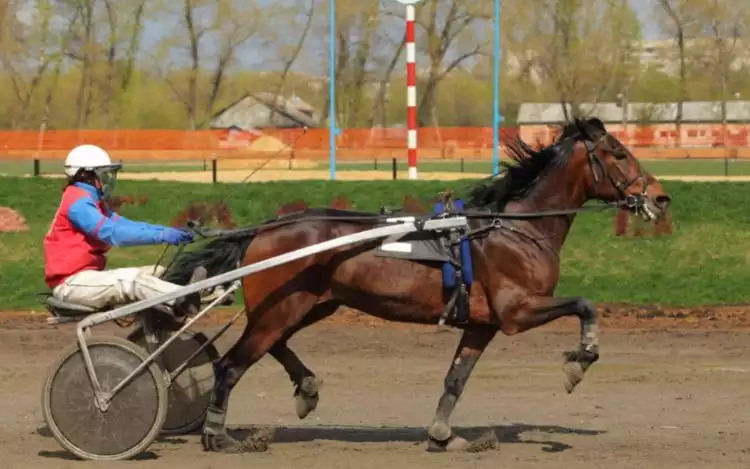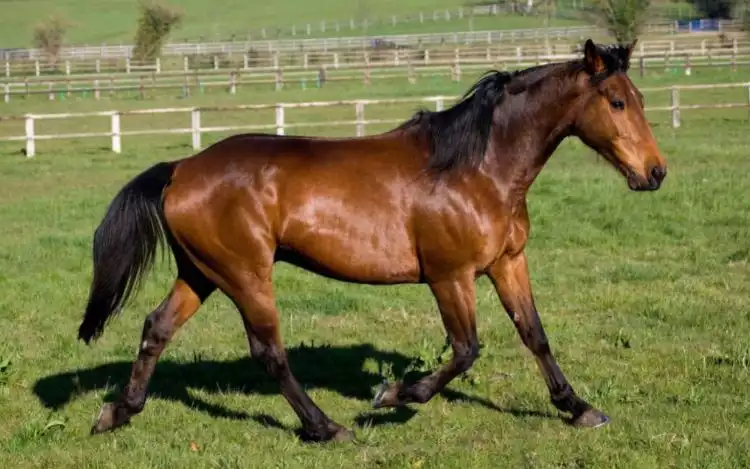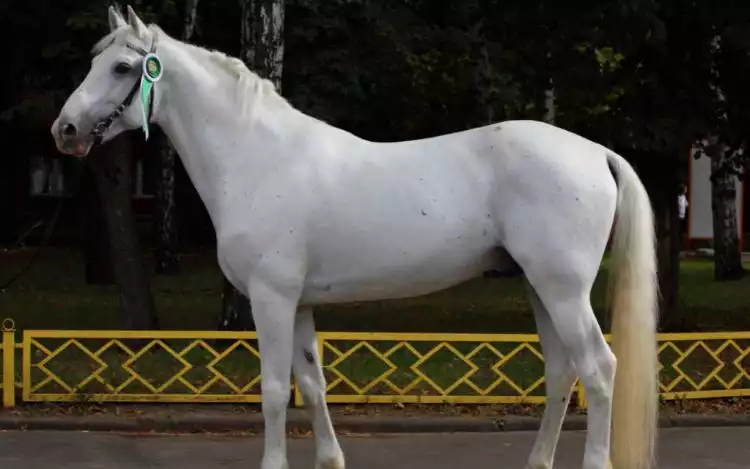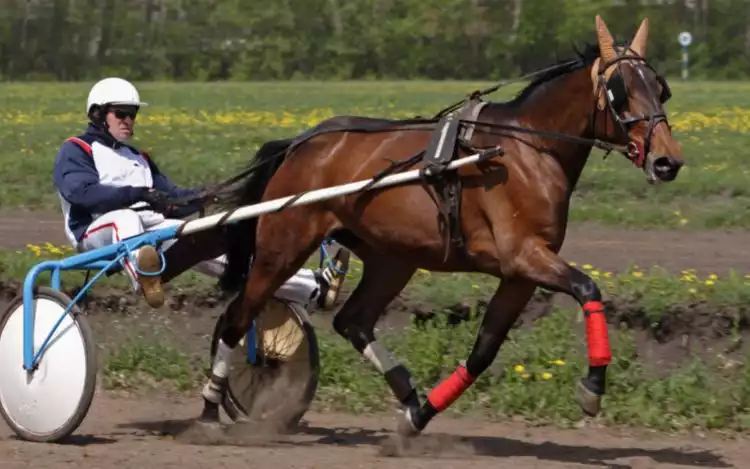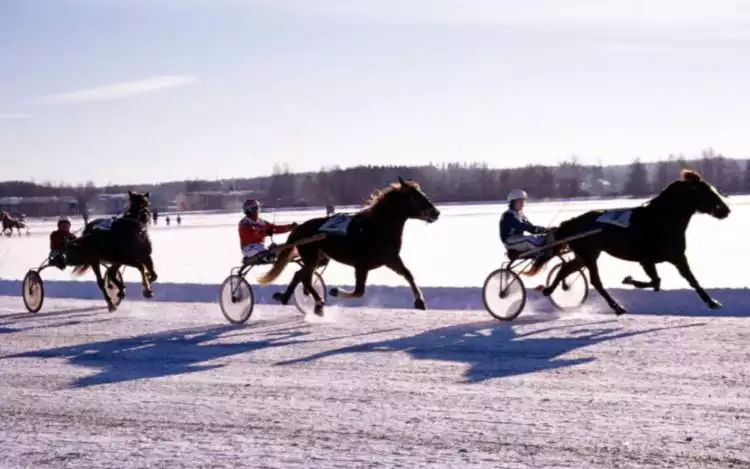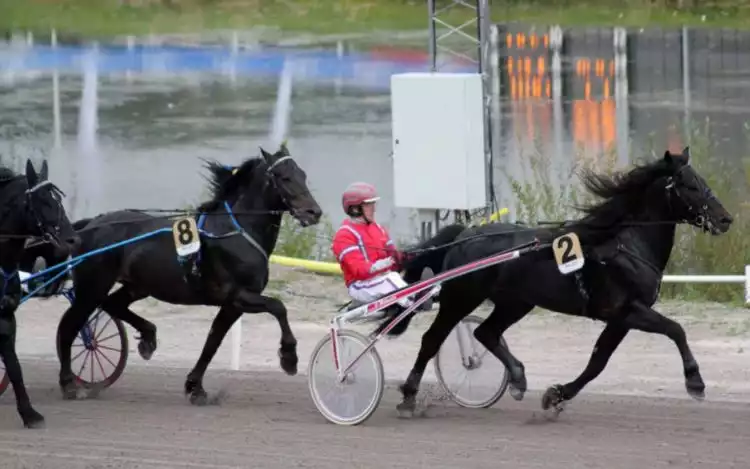Harness Horse Racing Guide
Harness racing is not as popular in the UK as thoroughbred but is a fascinating form of the sport. It involves horses pulling two-wheeled carts called sulkies across various tracks. This guide will provide an in-depth look at harness racing, offering insights and betting strategies.
Explore different harness racing styles, terminology, and more.
Types of Harness Racing
Harness racing comprises two main categories: Pacers and Trotters. These categories are defined by the horses' gaits, or movements, and each has its distinctive characteristics and horse racing bet types associated with them. In this section, we provide an overview of these two exciting racing styles.

Pacer
Pacers are renowned for their explosive speed. They move with a lateral gait, where the legs on one side of their body move in unison, resulting in a smooth and rapid stride. The emphasis in pacing races is on sustained speed, making them a thrilling spectacle for spectators and a unique challenge for bettors.
Trotter
Trotters, in contrast, exhibit a diagonal gait. Their legs move in pairs, creating an up-and-down motion. Trotting races require exceptional endurance and consistency, focusing on maintaining a controlled pace. Strategic finesse plays a pivotal role in the success of trotters and the races tend to be over longer distances than pacer races.
The Rules in Harness Racing
Harness racing, like any organised sport, operates under a set of rules and regulations to ensure fair and safe competition. In the UK, these are set by the British Harness Racing Club. The rules govern everything from horse eligibility and equipment to racing conduct.
Horse Eligibility: Horses must be at least three years old and meet performance criteria to compete in specific races. The age and experience of the horse, along with its gait preference (pace or trot), determine the races it can enter.
Sulky and Equipment: The design and specifications of the sulky and racing equipment are regulated to maintain fairness and safety. This includes the weight of the sulky and the use of a racing harness, which is sometimes known as a 5-point racing harness.
Racing Conduct: Rules dictate how horses should behave during a race, including requirements to maintain their gait and avoid interference with other competitors.
Doping and Medication: Strict anti-doping regulations are in place to prevent the use of performance-enhancing substances.
Judging and Penalties: Races are overseen by judges who enforce the rules and may issue penalties for infractions.
Understanding and adhering to these rules is essential for knowing how to bet in horse racing and to avoid disappointment. Violations can result in disqualification or penalties, making a thorough knowledge of the regulations critical for a successful experience in this sport.
What is a Sulky in Harness Racing
A sulky is a specialised two-wheeled cart designed for use in harness racing. It plays a crucial role as it is the vehicle to which the horse is harnessed, and the driver stands on the sulky as the horse pulls it. Sulkies come in various types that cater to different racing styles and purposes.
Standard Sulky
The standard sulky is the most common type used in harness racing. It is a lightweight, aerodynamic cart designed for speed. The driver stands on a small platform behind the horse, guiding it as they race. Standard sulkies are designed to minimize air resistance and allow horses to achieve their maximum pace.
Bike Sulky
A bike sulky, as the name suggests, resembles a bicycle more than a traditional sulky. It features a seat for the driver, allowing them to sit rather than stand. Bike sulkies are often used in trotting races and provide stability for the driver while maintaining a streamlined profile for the horse's performance.
Dog Sulky
Dog sulkies are smaller and lighter sulkies designed for training and conditioning horses. They are not typically used in official races but are valuable tools for preparing horses for competition. These sulkies are named "dog sulkies" because they are similar in size and design to sulkies used for training racing greyhounds.
Quad Sulky
The quad sulky is a less common type, designed for specific racing events. It features four wheels instead of the standard two, offering added stability and control for the driver. Quad sulkies are used in specific races and are often associated with trotting events where maintaining gait is of high importance.
Modern Harness Racing
Modern harness racing has evolved combining tradition with technological advances. Discover how racecourses, handicapping systems, and the intricacies of race starts affect horse betting.
Racecourse
Racing is conducted on professionally designed and meticulously maintained racecourses. These tracks are engineered to ensure safety and provide an optimal surface for horses and sulkies. The tracks are oval in shape, often featuring banked turns to aid in maintaining speed and balance during the race. We should also mention that a harness race is always run clockwise around the track.
Handicap
Handicapping in harness racing is a system designed to level the playing field. Horses are assigned weights or starting positions based on their past performance. This helps create competitive races and ensures that horses of varying abilities can compete on an equitable basis.
The Start
The race start is a crucial moment in harness racing. Modern starting systems, like mobile barrier gates or standing starts, are employed to ensure a fair beginning to the race. The starting process demands precision, as a well-executed start sets the tone for an exciting and competitive race.
Best Sites for Harness Racing Betting Online
BetMaze

Bet £20
Get £20
Free Bet
Quickbet

Bet £10, Get a £10 Free Bet
or a Casino Bonus of
100% up to £100
AlfoBet

Bet £20 and
Get £20 Free Bets
Horse Breeds that Compete in Harness Racing
Harness racing showcases a variety of horse breeds. These breeds have been selectively bred and trained to pull sulkies. Discover the horse breeds commonly seen in harness racing.
Standardbred
The Standardbred is a versatile and renowned breed, originating in the United States during the 18th century. These horses are the backbone of harness racing worldwide, known for their remarkable adaptability to both pacing and trotting. Standardbreds are typically large, standing around 15 to 16 hands high and weighing between 1,000 to 1,200 pounds. Their willingness to race and consistent performance make them exceptional competitors. A unique fact about the breed is that it was named ‘Standardbred’ because they were required to meet a specific standard time in a mile to be registered.
French Trotter
The French Trotter, as the name suggests, has its origins in France, where it was carefully developed during the 19th century. These horses are highly regarded for their trotting abilities and have contributed significantly to the sport of harness racing. French Trotters are typically smaller in size, standing around 14.2 to 15.2 hands high. Their distinguishing feature is their elegance and grace, both in appearance and movement. They are known for their smooth and rhythmic trot, which is well-suited for long-distance races.
Orlov Trotter
The Orlov Trotter, an esteemed Russian breed, has a rich history dating back to the late 18th century. It was meticulously bred to excel in harness racing, particularly trotting events. Orlov Trotters typically stand around 15 to 16 hands high and weigh between 1,000 to 1,200 pounds. Their distinctive trait is their remarkable trotting gait, marked by grace and endurance. This breed's consistency and precision in trotting races have solidified its reputation in the world of harness racing.
Russian Trotter
This remarkable breed has a fascinating history, and originates from Russia in the 19th century. These horses have been specifically bred for harness racing, to outperform the American Standardbred. Standing at around 15 to 16 hands, these horses have made significant contributions to harness racing, demonstrating remarkable consistency and precision in their trotting gait. While primarily used for racing, they are also versatile enough to excel in other equestrian pursuits.
Finnish Horse
Native to Finland, the Finnish horse is a versatile and enduring breed that finds application in various equestrian disciplines, including harness racing. They stand approximately 14 to 15 hands high and weigh around 900 to 1,100 pounds. Their robust build and temperament make them well-suited for both racing and work in forestry and agriculture. Finnish Horses are prized for their ability to maintain a controlled trot, which sets them apart in trotting competitions.
Scandinavian Coldblood Trotter
The Scandinavian Coldblood Trotter hails from the Nordic region and stands out due to its strength and reliability in harness racing, particularly in heavy-duty trotting events. They are typically larger, reaching heights of 15.2 to 16 hands and weighing around 1,100 to 1,300 pounds. This breed's unique trait is its power and ability to maintain a steady trot, even when carrying heavier loads. While renowned for their role in trotting races, Scandinavian Coldblood Trotters are also employed in various work-related tasks, reflecting their impressive versatility.
Harness Racing Final Thoughts
In conclusion, harness racing stands as a great variation of horse racing. The diversity of the horse breeds, gait styles, and the rich history of the sport contribute to making it an interesting betting opportunity too.
As in all forms of gambling, moderation and informed decision-making are key. At Gambling Zone we suggest you wager sensibly and always within your means.Harness Racing FAQs
Here are the most common questions we get asked about Harness Racing.
